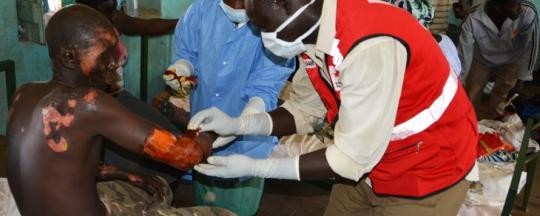The author is the country director of Save the Children in South Sudan. Here he describes his interactions with young people who suffered extensive burn injuries after a fuel tanker exploded in Maridi. The charity’s emergency health unit brought in a consignment of medical supplies worth more than $133,000 and also flew in a specialist plastic surgeon to conduct reconstructive surgery on patients who were badly disfigured.
I remember exactly where I was on 16th September when news broke that a fuel tanker had exploded in Maridi, Western Equatoria state. Initial reports suggested that up to 85 people who were siphoning fuel from the stricken truck had been killed by the high-octane inferno. As of today, more than 300 adults and children have died. Another 200, including children, suffered severe burns and are fighting for their lives in Maridi and Juba Teaching Hospital in the capital Juba!
I instantly knew that for Save the Children to respond effectively, I would have to visit Juba Teaching Hospital in person, see the patients, and speak to clinical and administrative staff to get a good appreciation of the extent and gravity of the challenge that awaits us.
Juba Teaching Hospital is a mere 3–5-minutes’ drive from our office. As we navigated through the chaotic traffic to enter the hospital, I remembered a time in 2014 when a caller into a radio talk show described Juba Teaching Hospital as “…the place where people go to die.” Of course it was an unfair exaggeration, but it still brought a sense of foreboding as I prepared to meet the victims.
Moment of Truth
You can read about it in newspapers, listen on radio, and even watch television images of the victims of the Maridi fuel tanker tragedy, but nothing really prepares you for a face-to-face encounter with the victims. As I entered the ward, my attention was immediately drawn to a little girl sitting on a bed to my right. She is called Suzie – a 16-year-old schoolgirl who was in primary six in Maridi.
Not a trace of the skin I saw on Suzie’s face could be seen on her legs – it’s all pink. Just below her knees, there are deep gapping wounds. Suzie’s legs may be in tatters, but her spirits and dreams are intact: “…The pain continues. But I will recover and go back to school. I want to work as a doctor, because the job deals with humanity, and I will come back here to treat patients,” Suzie said to me.
Weight of Responsibility
As I left Suzie’s ward, I took a quick glance around and saw at least 10 victims of the same tragedy – all burnt to different degrees – and all wearing desperate looks on their faces that seemed to say to me: “Save the Children, please do something – I want to get out of here.” Honestly, my legs felt heavy with the weight of responsibility as I took the few steps into the ward next door.
It was a much smaller ward – but there was nothing small about what I saw there. Right in front of me was a child who looked much younger than Suzie. I couldn’t tell whether the child was a boy or girl. The child’s face had burnt to the extent that I couldn’t detect any phenotypical features to give me a clue about the gender of the child. Only a few spots of dark skin could be seen on the little face that looked totally consumed by sadness – truly heartbreaking!
What’s your name, I asked the child? No reply was forthcoming, until a young man four beds away shouted: “Hadia…her name is Hadia”, as he stepped forward to translate for me. Hadia is a 12-year-old girl who was brought to hospital when she was in a very bad state. Doctors fought hard with basic equipment and medicine to save her life, and only a few wounds were now left on her body.
The same couldn’t be said about the hapless patient who was being treated right in front of 12-year-old Hadia in this small odor-filled ward that looked like a makeshift intensive care unit. With nothing more than a black undergarment on the badly burnt body, the patient’s head was slumped facedown, and his legs spread on the bed in a V-shape. As the Doctor bent over to apply antiseptic cream on a particular spot on the leg, I could see what looked like vibrating muscle spasms or twitches. That was the only sign of life I saw in this patient as I was led to the next ward.
A lot of things raced through my mind in the few seconds before we left the hospital. And, as if to confirm that I was rubbish at concealing my true emotions, one of our staff in the back seat asked: “What’s going through your mind Pete”? His question was right on cue – and I replied:
“I now have a very clear idea of the gravity of the problem, and of what we can, and should do to help. Seeing pregnant women severely burnt. Young children disfigured for life. Hundreds of children orphaned and will need protection and psychosocial support. We have a hospital with very basic equipment, few doctors, and it runs out of water at a time when burn victims, especially children, are at their most vulnerable to life-threatening infections. How can we not intervene?” I asked.
A Faint Voice Ringing Loud
As we drove off, the faint voice of a little girl who had suffered severe burns kept ringing loud in my head, and it’s unlikely to stop anytime soon. “…I want to go back to school. The problem is that my head teacher also died in the fire,” she said.
The views expressed in ‘opinion’ articles published by Radio Tamazuj are solely those of the writer. The veracity of any claims made are the responsibility of the author, not Radio Tamazuj.




